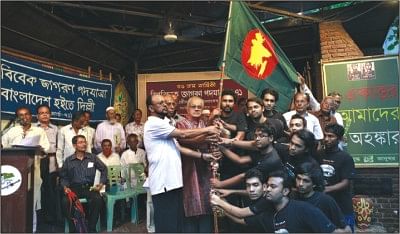1971 marchers recognised after 39 years

The Liberation War Museum authorities accord a reception to 30 heroes of the War of Liberation on the museum premises yesterday.Photo: STAR
"It just feels like the 1971," said Mohammad Abdus Samad, one of the 38 men who started marching from West Bengal to Delhi to raise public support for the War of Liberation in Bangladesh.
The Liberation War Museum authorities yesterday accorded a reception to these heroes of war on the museum premises. This league of extraordinary men was comprised of two men from 19 districts of the then East Pakistan, now Bangladesh.
In 39 years, this was the first time that as many as 30 members of the group gathered in one place. Two of the team members could not make it to the reception, as they are ill while six are now abroad.
Carrying a banner that read “Biswa Bibek Jagoron Podojatra” (March for global consciousness) these 38 men started marching from Baharampur of Murshidabad in West Bengal towards the Indian capital of Delhi on October 15, 1971.
Their aim was to reach Delhi by January 1972 and approach different foreign embassies and media to drum up support for the liberation of Bangladesh.
The heroes, however, did not need to go all the way to Delhi, as the country won its liberty on December 16, 1971 when the team reached Lucknow, a Northern province in India. Overwhelmed with joy, they return to the free motherland they always wished for.
"We thought that the history had forgotten us. But now it feels that we are back. I cannot express my ecstasy in words," Ahiduzzaman Chaklader, a proud member of the team, told The Daily Star.
Abdul Khalek, the team leader, could not hold his tears when he was asked to introduce his teammates to the audience.
He said they used to walk 20 to 25 kilometres each day and hold rallies mainly in the Urdu speaking Muslim majority areas. "We did not stop even some of us fell sick. We strove for achieving our goal."
The museum authorities first came across Dilip Kumar Nag, one of the team members, during a visit to Sahbajpur High School at Brahmanbaria in August last year. From Dilip Nag they got two of the group members and then traced the rest following a reception programme that was reported in different dailies.
Anil Kumar Biswas, another proud member of the team, said, "We look so young in the procession pictures of 1971. We were between 20 and 25 when we started our journey. Now we are around 60 and bearing the time in our faces."
The museum authorities honoured the heroes with citation and flowers while the heroes handed over a flag of Swadhin Bangla (the first national flag with the country map emblazoned in the red circle) to ten youths who will start another march today from the Liberation War Museum premises to Sunamganj to raise fund for the proposed new building for the museum.
Some members of the group handed over pictures, books and other belongings they used during their campaign to the museum authorities to share their spirit of 1971 with the post-liberation generations.
The heroes urged the government to find out the gallant but humble freedom fighters who are still not in the freedom fighters' list.
Attending the programme, Planning Minister and Deputy Commander-in-Chief of the Liberation War AK Khandker said, "The country has found the lost gold by discovering the great heroes."

 For all latest news, follow The Daily Star's Google News channel.
For all latest news, follow The Daily Star's Google News channel. 




Comments